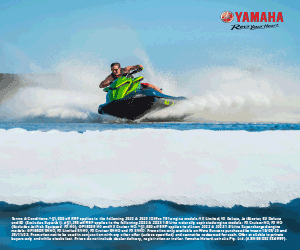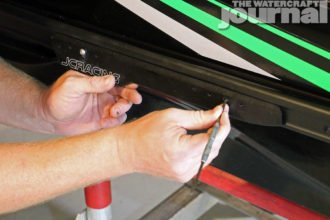
Two weeks ago, people thought we were joking when The Watercraft Journal revealed that Honda has been parading a new 3-seater runabout around to various test audiences for the past two years (yes! that story was from last year’s Miami Boat Show). In fact, given the minimalist effort Honda made to advertise its Aquatrax watercraft to the four nations it was made available, few could really take the news seriously. That is why we’re reticent to let you know what Polaris has cooking.
For those paying attention to the powersports industry (outside of PWC sales), you’ll know that there has been quite a few highs and lows for the domestic manufacturer of side-by-sides, snowmobiles, motorcycles, ATV, and electric vehicles. Only in January did the OEM announce the closure of its famed Victory motorcycle brand, with Polaris Industries Chairman and CEO Scott Wine stating, “Over the past 18 years, we have invested not only resources, but our hearts and souls, into forging the Victory Motorcycles brand, and we are exceptionally proud of what our team has accomplished.”
Wine justified the decision, stating “This move allows us to optimize and align our resources behind both our premium, high performing Indian Motorcycle brand and our innovative Slingshot brand, enhancing our focus on accelerating the success of those brands.” Yet, what Wine left out of his public address was the deepening of Polaris’ relationship with a certain engine manufacturer and the widening of the company’s portfolio into the personal watercraft category (yet again).

Polaris is the SxS leader with over a 50-percent share of the market and “a stranglehold on the hero-building Pure Sport segment with the company’s RZR performance vehicles,” according to SuperTraxMag. Moreover, Polaris’ snowmobile division is the second most successful in the marketplace. Placing Polaris at the top of the SxS heap is their turbocharged Pro Star DOHC twin 4-strokes producing 168-horsepower (from a 1L no less!). But unless we were talking about Sea-Doo GTIs and Yamaha VX’s, that’s simply not enough to cut it.
Interestingly, General Motors revealed it will be investing $233 million into its small engine production at its Spring Hill manufacturing complex. The Spring Hill facility currently manufactures GM’s Ecotec 2.0L, 2.4L and 2.5L 4-cylinder engines, including direct-injection and turbocharged variants. And why this matters is because, as per Polaris’ CEO Scott Wine, it’s looking to “expand” its Slingshot line and “deepen” its relationship with General Motors, who supplies the Ecotec LE9 2.4L DOHC for the three-wheeled street trike.
In it’s current form, the Ecotec LE9 displaces 2,384cc making it, effectively, the largest displacement engine in the PWC market. Equally, the DOHC (dual overhead camshaft) VVT (variable valve timing) allows the Ecotec to perform at various speeds better than current overhead cam engine platforms, producing a strong 173 naturally-aspirated horsepower @ 6,200 rpm. Conversely, the turbocharged version adds an additional 92-horsepower at the flywheel, pushing the Ecotec’s output to over 260-horsepower – well within the range of the Yamaha SVHO (Super Vortex High Output) – at 265HP.

In a brief exchange of emails with Polaris’ Social Media Coordinator, Shana M. O’Hara, plans for an aggressive, full-sized 3-person watercraft have been “in the making” since the brand’s withdrawal from PWC in 2005. O’Hara states, “The image of the clay sculpt [above] is of a prototype runabout [rumored to be named either the “Icon” or the “Element” -Ed.] similar to what the final product would have been but was never released.” O’Hara hinted that interest in returning to PWC began in “early 2014” with the advent of the Sea-Doo Spark’s release. “We thought it was a very bold move [for Sea-Doo] and got us reconsidering our program.”
Although inspired by the entry-level Spark, Polaris has no intention of starting off small. “It’ll definitely carry some Slingshot DNA,” O’Hara needled, giving us ample room to believe the Ecotec 2.4L will reside beneath the bench seat; and as next year promises to deliver a turbocharged Slingshot to the public, so too will the GM-supplied 2.4L find a home in the future Polaris. The hull itself is expected to share much with the brand’s old flagship the aggressively designed limited edition Matrix (a derivative of the previous MSX 140 that has been discontinued for 2005, Jeff Hemmel once wrote back in 2004), capable of top speeds reaching up and beyond 67 mph with a full tank of required 92 octane fuel.
The model shown is a dated one, as indicated by the minuscule sponsons and lacking left-side brake/reverse lever. The Maxtrix though, was surprisingly avante guarde for its time, with scalloped fairings giving the runabout a early Ergolock design, predating the current RXP-X by nearly a decade. We expect changes to the sloping seat to take a more tiered look, and the unusual nodules on the nose to vanish. Obviously, we don’t expect the return of a Polaris watercraft to happen overnight, but as the brand expands its reach (and market share), so should logic follow that a return to PWC would be imminent. Competition breeds excellence and we’re excited to welcome a fifth manufacturer to the field. For all future updates on the coming Polaris return, make sure to check in HERE regularly.















Kevin Shaw with continued dumbassery… it’s been LONG confirmed that the SVHO makes 306hp stock! Kevin, stop just regurgitating the common (non) knowledge shit that is out there…
Will, I have the dyno sheets. The SVHO makes 254 flywheel horsepower.